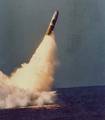Iran’s “Power of Deterrence”
The display of Iran's military capabilities is intended to deter US war plans

On November 2, Iran tested three new types of land-to-sea and sea-to-sea missiles in the context of its “Great Prophet II” military exercises carried out on land in the desert (See images below), in the Persian Gulf waters, the Sea of Oman and 14 of Iran’s provinces.
Western and Israeli military analysts were taken by surprise. According to Debka, the Israeli intelligence publication (5 November), several features of Iran’s military capabilities were unknown to the Pentagon:
“The spectacular swarm of sophisticated missiles fired in Iran’s surprise military exercise stuns military planners in the US, Israel and Europe”
Iran’s tests of surface missiles on November 2 were marked by precise planning in a carefully staged operation. According to a senior American missile expert (quoted by Debka), “the Iranians demonstrated up-to-date missile-launching technology which the West had not known them to possess.”
“They also displayed unfamiliar warheads. But their most startling feat was the successful first test-fire of the long-range Shehab-3 with its cluster of tens of small bomblets, …
The entire range bore the imprint of new purchases from China. This Shehab-3, whose 2,000-km range brings Israel, the Middle East and Europe within reach – may be more than a match for any anti-missile missile system in American, Israeli or European arsenals – depending critically on the point of its fragmentation. Some of its features are still an enigma in the West. If the Shehab-3’s cluster separates close to target, the Israel-US Arrow has a chance to intercept it, but the Americans and Israelis have no defense against the multiple warhead if it separates at a distance.” (Debka, November 5, 2006)
Iranian state television showed dozens of missiles being launched both from warships in the Persian Gulf as well as from land based locations in the desert.


According to Uzi Rubin, former head of Israel’s anti-ballistic missile program, “the intensity of the military exercise was unprecedented… It was meant to make an impression — and it made an impression.” (www.cnsnews.com 3 November 2006)
“It was a ‘technical and operational achievement’ said Rubin, pointing to the fact that the Iranians were able to launch so many missiles.” (Ibid)
The display has reached its objective. The Head of Iran’s Revolutionary Guards, General Yahya Rahim Safavi, confirmed that the missile test was conducted “to show our deterrent and defensive power to trans-regional enemies, and we hope they will understand the message.”
“It was a clear reference to the U.S., Britain and France, who were among six nations that participated in U.S.-led maneuvers in the Gulf earlier this week. Those exercises focused on surveillance, however.
Secretary of State Condoleezza Rice said in a radio interview that she believed that the Iranians “are trying to demonstrate that they are tough.” (Ibid)
The exercises, while creating a political stir in the US and Israel, do not seem to have thwarted the US-Israeli resolve to wage a preemptive war on Iran. In the words of Israel’ foreign minister:
“It is time for the international community to act decisively and through the vehicle of the Security Council to send a clear message that if they (Iran) continue on their current path, they will incur the wrath of the community of nations,” Regev said by telephone on Friday.
Post Cold War Deterrence
Since August, Iran has been involved in major war games.
These military exercises are part of a new post-cold war deterrence on the part of the Tehran government..
The objective is to neutralize US threats regarding Tehran’s alleged nuclear weapons program.
The display of Iranian military capabilities is intended to deter US and coalition war plans, which are currently in an advanced state of readiness. The latter is marked by a massive build-up of US and coalition war vessels in the Persian Gulf, the Arabian Sea and the Eastern Mediterranean. (See Nazemroaya, Oct 2006, Chossudovsky, October 2006)
“Deterrence” and “containment” can also be used against the US. In a recent statement by Iran’s Foreign Ministry, the objective of the war games were described as follows:
“Our maneuvers are not meant to pose a threat to any country. They are, rather, aimed at reinvigorating Iran’s power of deterrence”
Will these developments deter the Bush administration from embarking upon the next stage of its Middle East military adventure?
Will US and Israeli military planners exercise restraint?
One would hope that “Post Cold War deterrence” directed against the US might contribute to temporarily thwarting Washington’s military agenda.
On the other hand, we should understand that both sides on an active war footing.
The situation in the Persian Gulf is extremely tense. The massive deployment of US and coalition naval power within a short distance from the Iranian coastline constitutes an act of provocation. This deployment marked by ongoing US war games could trigger an incident which could potentially lead to war.
It is therefore essential in the weeks and months ahead, that citizens’ movements in the US and around the world act consistently to confront their respective governments and reverse and dismantle this military agenda. (For details, see Michel Chossudovsky, Post Cold War Shivers, October 2006).
Michel Chossudovsky is the author of the international best America’s “War on Terrorism” Second Edition, Global Research, 2005. He is Professor of Economics at the University of Ottawa and Director of the Centre for Research on Globalization.
To order Chossudovsky’s book America’s “War on Terrorism”, click here
Note: Readers are welcome to cross-post this article with a view to spreading the word and warning people of the dangers of a broader Middle East war. Please indicate the source and copyright note.


